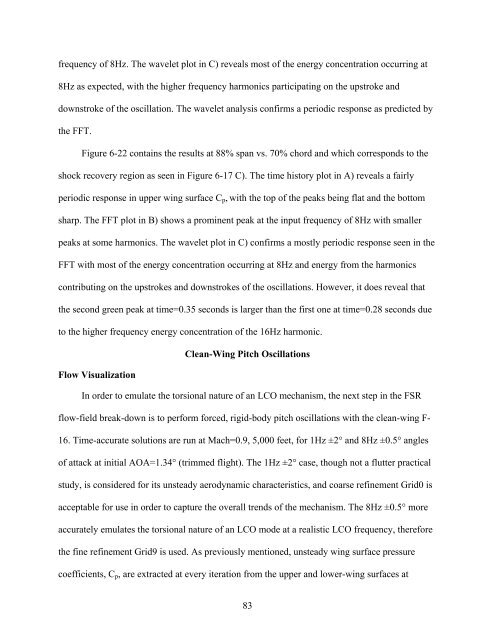university of florida thesis or dissertation formatting template
university of florida thesis or dissertation formatting template
university of florida thesis or dissertation formatting template
You also want an ePaper? Increase the reach of your titles
YUMPU automatically turns print PDFs into web optimized ePapers that Google loves.
frequency <strong>of</strong> 8Hz. The wavelet plot in C) reveals most <strong>of</strong> the energy concentration occurring at<br />
8Hz as expected, with the higher frequency harmonics participating on the upstroke and<br />
downstroke <strong>of</strong> the oscillation. The wavelet analysis confirms a periodic response as predicted by<br />
the FFT.<br />
Figure 6-22 contains the results at 88% span vs. 70% ch<strong>or</strong>d and which c<strong>or</strong>responds to the<br />
shock recovery region as seen in Figure 6-17 C). The time hist<strong>or</strong>y plot in A) reveals a fairly<br />
periodic response in upper wing surface Cp, with the top <strong>of</strong> the peaks being flat and the bottom<br />
sharp. The FFT plot in B) shows a prominent peak at the input frequency <strong>of</strong> 8Hz with smaller<br />
peaks at some harmonics. The wavelet plot in C) confirms a mostly periodic response seen in the<br />
FFT with most <strong>of</strong> the energy concentration occurring at 8Hz and energy from the harmonics<br />
contributing on the upstrokes and downstrokes <strong>of</strong> the oscillations. However, it does reveal that<br />
the second green peak at time=0.35 seconds is larger than the first one at time=0.28 seconds due<br />
to the higher frequency energy concentration <strong>of</strong> the 16Hz harmonic.<br />
Flow Visualization<br />
Clean-Wing Pitch Oscillations<br />
In <strong>or</strong>der to emulate the t<strong>or</strong>sional nature <strong>of</strong> an LCO mechanism, the next step in the FSR<br />
flow-field break-down is to perf<strong>or</strong>m f<strong>or</strong>ced, rigid-body pitch oscillations with the clean-wing F-<br />
16. Time-accurate solutions are run at Mach=0.9, 5,000 feet, f<strong>or</strong> 1Hz ±2° and 8Hz ±0.5° angles<br />
<strong>of</strong> attack at initial AOA=1.34° (trimmed flight). The 1Hz ±2° case, though not a flutter practical<br />
study, is considered f<strong>or</strong> its unsteady aerodynamic characteristics, and coarse refinement Grid0 is<br />
acceptable f<strong>or</strong> use in <strong>or</strong>der to capture the overall trends <strong>of</strong> the mechanism. The 8Hz ±0.5° m<strong>or</strong>e<br />
accurately emulates the t<strong>or</strong>sional nature <strong>of</strong> an LCO mode at a realistic LCO frequency, theref<strong>or</strong>e<br />
the fine refinement Grid9 is used. As previously mentioned, unsteady wing surface pressure<br />
coefficients, Cp, are extracted at every iteration from the upper and lower-wing surfaces at<br />
83
















